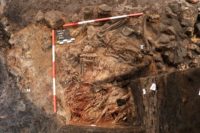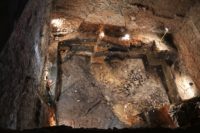 The excavation of Břeclav Castle in the Czech Republic, has unearthed the skeletal remains of three people in the medieval foundations, possibly the victims of ritual sacrifice. The individuals were found under the 11th century walls discovered last year. They had been placed next to each other over the first layer of stone of the rampart and their positions suggest they may have been tied together. An iron object a foot and a half long was placed over them. It is tapered on one end, but the object is too corroded to be identified.
The excavation of Břeclav Castle in the Czech Republic, has unearthed the skeletal remains of three people in the medieval foundations, possibly the victims of ritual sacrifice. The individuals were found under the 11th century walls discovered last year. They had been placed next to each other over the first layer of stone of the rampart and their positions suggest they may have been tied together. An iron object a foot and a half long was placed over them. It is tapered on one end, but the object is too corroded to be identified.
“These unfortunates seem to have fallen victim to some drastic pagan practice, or murder”, explains [archaeologist Miroslav] Dejmal. “It is hard to imagine that all three died at the same time by accident. And most importantly, placing them on the first layer of stones of the newly rampart and the position of the bodies, suggests they were in fact sacrificed.” […]
“Next week, together with anthropologists, we will try to learn more about the dead. We’ll see if we can find out if they were related or whether they were ‘locals’. It has been suggested that they might be slaves, possibly prisoners of war, who were used to build the walls and then perhaps sacrificed or executed. Even though the rampart builders had been converted to Christianity by around 1050, many, often harsh, pagan practices still survived.”
 I would hesitate to chalk this up to the work of crypto-pagans. The builder of the castle, Bretislav I, Duke of Bohemia, was Christian, as was his father, his father before him and so on all the way back to the first Duke of Bohemia, Bořivoj I, in the 9th century. The Přemyslid dynasty includes two saints, Ludmila and her grandson Wenceslaus of Christmas carol fame. Christianity was well-established by the early 11th century, two denominations of it (Slavic Orthodox and Roman Catholic), no less. If the trio was indeed sacrificed for the good of the castle, you can’t assume Bretislav and/or his subordinates didn’t have knowledge of it or even a hand in it. It certainly couldn’t have been done without people on site being aware of it.
I would hesitate to chalk this up to the work of crypto-pagans. The builder of the castle, Bretislav I, Duke of Bohemia, was Christian, as was his father, his father before him and so on all the way back to the first Duke of Bohemia, Bořivoj I, in the 9th century. The Přemyslid dynasty includes two saints, Ludmila and her grandson Wenceslaus of Christmas carol fame. Christianity was well-established by the early 11th century, two denominations of it (Slavic Orthodox and Roman Catholic), no less. If the trio was indeed sacrificed for the good of the castle, you can’t assume Bretislav and/or his subordinates didn’t have knowledge of it or even a hand in it. It certainly couldn’t have been done without people on site being aware of it.
Foundation sacrifice stories abound in the folklore of many cultures around the world. Numerous countries in Eastern Europe — Serbia, Albania, Romania, Bulgaria, Hungary — have folk songs dedicated to a legendary foundation sacrifice. The Walled-Up Wife and its many variants tell of masons building a castle whose work is magically dismantled every night. They learn that they must wall up the first woman who visits the next day in order to break the nefarious spell and finish construction. The architect’s wife turns out to be the unfortunate victim.
Folklorists beginning with Jacob Grimm, the elder of the fairy tale-collecting brothers, have hypothesized that the foundation sacrifice stories originate with pre-Christian rituals dedicated to appeasing deities/spirits of the landscape angered by people building things on their turfs. Want to build a bridge over a river? Better give the river god some recompense for all the future drowning victims he’s going to miss out on.
The New Statistical Account of Scotland (1845) recounts that no less Christian a figure than St. Columba, the Irish missionary who evangelized the Scots in the 6th century, buried his best friend in the foundations of the monastery of Iona.
When Columba first attempted to build on lona, the walls, it is said, by the operation of some evil spirit, fell down as fast as they were erected. Columba received supernatural information that they would never stand unless a human victim was buried alive. According to one account, the lot fell on Oran, the companion of the saint, as the victim that was demanded for the success of the undertaking. Others pretend that Oran voluntarily devoted himself, and was interred accordingly. At the end of three days Columba had the curiosity to take a farewell look at his old friend, and caused the earth to be removed. Oran raised his swimming eyes, and said, “There is no wonder in death, and hell is not as it is reported.” The saint was so shocked at this impiety that he instantly ordered the earth to be flung in again, uttering the words, “Uir! Uir! air beal Orain ma’n labhair e tuile comh’radh,” that is, “Earth! Earth! on the mouth of Oran that he may blab no more.”
The author shares the juicy story but doubts its veracity, accusing the “druids” of having made it all up to slander Columba and Christianity “especially as the savage rite imputed to him was only practised by the heathens.” 